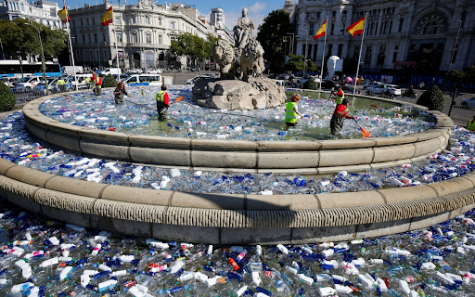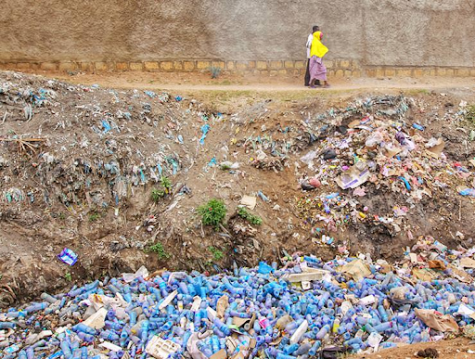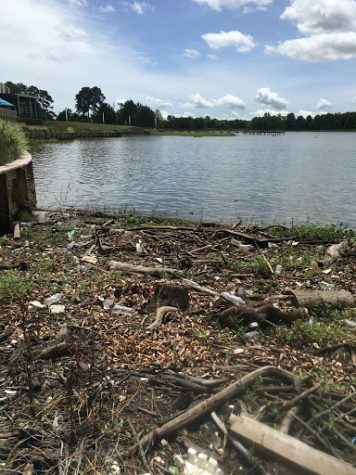The Journey of Plastic Bottles Around the World
May 24, 2020
Plastic bottles continue to remain highly relevant to our daily lives and economy, sold in places like vending machines, sandwich shops, and sports games. This genius invention is one of convenience and controversy. Commercially, the first plastic bottles were produced in 1973, filled with drinks ranging from Coca-Cola and 7-Up to sparkling water. Mechanical engineer Nathaniel Wyeth was the inventor who patented their Polyethylene Terephthalate (PET) structure. It was the first of its kind able to withstand the high pressures of carbonated beverages. As the years went on, more and more people bought into the convenience of the plastic bottle. In the early 2000’s companies began marketing bottled water as a much cleaner form compared to tap water, which they claimed made you sick. Celebrities and athletes shot commercials strutting around with the translucent bottles in hand. With all its fame and fortune, however comes a huge cost. Today roughly one million plastic bottles are sold each minute and in the United States, only 30% of these bottles are recycled. One bottle will take an estimated 700 years to dissolve completely. It is estimated that in 2021 there will be 583.3 billion PET bottles produced annually around the globe. The materials within PET are refined from crude oil. 17 million barrels of crude oil are used to keep up with the United States’s annual demand for plastic bottles. Without question, plastic bottles take immense amounts of energy to produce and degrade. Pictured below are some landmarks showing the infestation of plastic bottles around the world.

Cibeles Fountain, Madrid
Madrid fills the iconic Cibeles Fountain with thousands of plastic bottles to create an artistic expression of the impacts of plastic bottles.

Kamilo Point Beach, Hawaii
Kamilo Point beach is considered one of the dirtiest beaches on earth. This beach displays several forms of plastic and waste. The large amounts of plastic lying on the shores pose a threat to marine life and the beach’s future. It has been found that fish in Hawaii begin eating plastic particles days after being born. The beach’s past inaccessibility has caused the build-up, but recent efforts are being made to preserve the island’s beauty and cleanliness.

Buriganga River, Bangladesh
The Buriganga River used to serve as a main waterway for transporting goods and communicating across towns, but since then it has become a dumping ground for the estimated 97,000 US tons (roughly 87,000 metric tonnes) of plastic discarded in Bangladesh every year. All the fish who once inhabited this shrinking river have died off. The River now serves as nothing more than a flowing trash can.

Harar, Ethiopia
A couple is pictured strolling along a canal filled with colorful plastic bottles and waste.

Lake Houston, Texas
Lakefront restaurants, Sharky’s, Chimichurri, Zammitti’s, and Raffa’s boast views of Lake Houston, but piles of plastic bottles and debris as well. People stroll along the Lakeside, while throwing their bottles and trash beside the river.
Although plastic pollution is a daunting affair, companies strive to become more green and anti-plastic. One of these companies is Avantium, a biochemical company based in The Netherlands hoping to lead the way in plant plastics. They strive to create plastics from plant sugar, instead of fossil fuels that can compost much quicker than traditional plastics. The company’s plan is supported by Coca-Cola, Danone, and beer company Carlsberg. Avantium plans to produce their plant plastic out of beets, corn, or wheat until they have access to sustainably sourced biowaste. This switch will prevent conflict with global food supply, as the company begins to expand. Other global leaders in reducing plastic waste include London, San Francisco, Belgium, and Sweden who are all turning to more sustainable methods of production and practice. The globe continues to be riddled with this growing crisis, but new innovations and policies can offer a greener future rather than one swimming in plastic.
Interesting plastic consumption graphics: https://graphics.reuters.com/ENVIRONMENT-PLASTIC/0100B275155/index.html
Works Cited
Ali, Shawkat. “’Plastic River!’.” The Business Standard, 13 Jan. 2020, https://tbsnews.net/environment/plastic-river-35939. Accessed 23 May 2020.
Ambrose, Jillian. “The End of Plastic? New Plant-Based Bottles Will Degrade in a Year.” The Guardian, Guardian News and Media, 16 May 2020, www.theguardian.com/environment/2020/may/16/the-end-of-plastic-new-plant-based-bottles-will-degrade-in-a-year. Accessed 23 May 2020.
Barney, Liz, and Michelle Broder Van Dyke. “Welcome to Hawaii’s ‘Plastic Beach’, One of the World’s Dirtiest Places.” The Guardian, Guardian News and Media, 10 Jan. 2020, www.theguardian.com/us-news/2020/jan/10/kamilo-beach-plastic-hawaii-pollution. Accessed 23 May 2020.
Calovini, Lisa. “The History and Future of the Plastic Water Bottle.” Shini USA, 24 June 2019, www.shiniusa.com/2017/06/14/the-history-and-future-of-the-plastic-water-bottle/. Accessed 23 May 2020.
Cressey, Daniel. “Bottles, Bags, Ropes and Toothbrushes: the Struggle to Track Ocean Plastics.” Nature News, Nature Publishing Group, 17 Aug. 2016, www.nature.com/news/bottles-bags-ropes-and-toothbrushes-the-struggle-to-track-ocean-plastics-1.20432. Accessed 23 May 2020.
Fitzgerald, Sunny. “25 Places That Have Committed to Going Zero-Waste.” 25 Cities That Are Committed to Going Zero-Waste Soon, 30 Oct. 2018, www.nationalgeographic.com/travel/lists/zero-waste-eliminate-sustainable-travel-destination-plastic/. Accessed 23 May 2020.
Garside, M. “PET Global Bottle Production 2021.” Statista, 3 Sept. 2019, www.statista.com/statistics/723191/production-of-polyethylene-terephthalate-bottles-worldwide/. Accessed 23 May 2020.
Kralj, Ivan. “Travel Industry against Plastic Pollution.” Pipeaway, 3 Aug. 2019, www.pipeaway.com/plastic-pollution-travel-industry/. Accessed 23 May 2020.
“Pictures of the Day: 21 October 2017.” The Telegraph, Telegraph Media Group, 21 Oct. 2017, www.telegraph.co.uk/news/2017/10/21/pictures-day-21-october-2017/landmark-cibeles-fountain-filled-plastic-bottles-illuminated/. Accessed 23 May 2020.
Razu, kazi salahuddin. “Buriganga Pollution.” Smithsonian.com, Smithsonian Institution, 2017, www.smithsonianmag.com/photocontest/detail/natural-world/buriganga-pollution/. Accessed 23 May 2020.
“Reasons to Avoid Bottled Water.” Sustainability at Harvard, 13 Nov. 2013, https://green.harvard.edu/tools-resources/green-tip/reasons-avoid-bottled-water. Accessed 23 May 2020.
Whitaker, Hannah. “How the Plastic Bottle Went from Miracle Container to Hated Garbage.” National Geographic, 18 Oct. 2019, www.nationalgeographic.com/environment/2019/08/plastic-bottles/. Accessed 23 May 2020.
